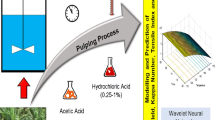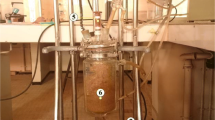Abstract
Response surface methodology based on the central composite design was used to investigate modeling and optimizing the individual and interactive effects of independent process variables (temperature, pulping time, ethanol concentration and alkali concentration) on the yield, kappa number and brightness of the pulp produced from the bamboo species Yushania alpina. Based on the central composite design, quadratic models and two-factor interactions were developed and correlated the pulp yield, kappa number and brightness of the pulps. The most significant parameters that affect the pulp yield, kappa number and brightness of the pulp were found to be temperature, ethanol concentration and alkali concentration, respectively. The optimum process variables were found at a cooking temperature of 162.30 °C, cooking time of 180 min, ethanol concentration of 60% and alkali concentration of 18.03% producing maximum pulp yield of 53.56% and brightness of 63.85%, and minimum kappa number of 11.65, and desirability of 0.882. In addition, the chemical analysis of Y. alpina chips was compared with different bamboo species. The predicted optimum conditions provided tensile index, burst index and tear index of 48.25 kN m/kg, 2.95 kPa m2 and 2.80 N m2/kg, respectively, and were experimentally confirmed. In general, the findings of the study show that pulp produced from the bamboo species Y. alpina is a suitable raw material for the paper and pulp industry.






Similar content being viewed by others
References
Bano A, Irfan M (2019) Alkali pretreatment of cotton stalk for bioethanol. Bangladesh J Sci Ind Res 54(1):73–82. https://doi.org/10.3329/bjsir.v54i1.40733
Bas D, Boyacı IH (2007) Modeling and optimization I: usability of response surface methodology. J Food Eng 78:836–845. https://doi.org/10.1016/j.jfoodeng.2005.11.024
Berhanu H, Kiflie Z, Neiva D, Gominho J, Feleke S, Yimam A, Pereira H (2018) Optimization of ethanol–alkali delignification of false banana (Ensete ventricosum) fibers for pulp production using response surface methodology. Ind Crops Prod 126(April):426–433. https://doi.org/10.1016/j.indcrop.2018.08.093
Cao S, Ma X, Lin L, Huang F, Huang L, Chen L (2014) Morphological and chemical characterization of green bamboo (Dendrocalamopsis oldhami (Munro) Keng f.) for dissolving pulp production. BioResources 9(3):4528–4539. https://doi.org/10.15376/biores.9.3.4528-4539
Correia V, Curvelo AA, Marabezi K, Almeida AEF, Savastano Junior H (2015) Bamboo cellulosic pulp produced by the ethanol/water process for reinforcement applications. Ciênc Florest Santa Maria 25(1):127–135. https://doi.org/10.5902/1980509817470
Feng Z, Ale R (2001) Soda-AQ pulping of reed canary grass. Ind Crops Prod 14:31–39. https://doi.org/10.1016/s0926-6690(00)00086-8
Gao L, Luo S, Guo W (2019) Optimization of performance of bamboo mat corrugated sheets using response surface methodology. Wood Fiber Sci 51(3):1–12. https://doi.org/10.22382/wfs-2019-026
Gellerstedt G, Pettersson I (1982) Chemical aspects of hydrogen peroxide bleaching. Part II the bleaching of kraft pulps. J Wood Chem Technol 2(3):231–250. https://doi.org/10.1080/027
Gilarrahz AM, Oliet M, Rodriguez F, Tijero J (1998) Ethanol–water pulping: cooking variables optimization. Can J Chem Eng 76:253–260. https://doi.org/10.1002/cjce.5450760213
He J, Cui S, Wang S (2008) Preparation and crystalline analysis of high-grade bamboo dissolving pulp for cellulose acetate. J Appl Polym Sci 107:1029–1038. https://doi.org/10.1002/app.27061
Hietanen TM, Österberg M, Backfolk KA (2013) Effects on pulp properties of magnesium hydroxide in peroxide bleaching. BioResources 8(2):2337–2350. https://doi.org/10.15376/biores.8.2.2337-2350
Ilvessalo-Pfäffli MS (1995) Fiber atlas—identification of papermaking fibers. Springer, Heidelberg, p 316
Jahan MS, Rahman MM (2012) Effect of pre-hydrolysis on the soda-anthraquinone pulping of corn stalks and Saccharum spontaneum (kash). Carbohydr Polym 88(2):583–588. https://doi.org/10.1016/j.carbpol.2012.01.005
Jiménez L, Perez I, Garcia JC, Lopez F, Ariza J (2004a) The influence of the ethanol pumping of wheat straw and of the beating of pulp on the resulting paper sheets. Wood Sci Technol 38:127–137. https://doi.org/10.1007/s00226-003-0212-6
Jiménez L, Rodríguez A, Pérez I, Calero AM, Ferrer JL (2004b) Ethylene glycol/soda organosolv pulping of olive tree trimmings. Wood Fiber Sci 36(3):423–431
Jiménez L, Rodriguez A, Perez A, Moral A, Serrano L (2008) Alternative raw materials and pulping process using clean technologies. Ind Crops Prod 28:11–16. https://doi.org/10.1016/j.indcrop.2007.12.005
Kassahun T (2015) Review of bamboo value chain in Ethiopia. Int J Afr Soc Cult Tradit 2(3):52–67
Khristova P, Karar NG, Kordsachia O, Patt R, Khider T (2006) Environmentally friendly pulping and bleaching of bagasse. Ind Crops Prod 23:131–139. https://doi.org/10.1016/j.indcrop.2005.05.002
Ma X, Huang L, Cao S, Chen Y, Luo X, Chen L (2012) Preparation of dissolving pulp from bamboo for textile applications. Part 2. Optimization of pulping conditions of hydrolyzed bamboo and its kinetics. BioResources 7(2):1866–1875. https://doi.org/10.15376/biores.7.2.1866-1875
Marrakchi Z, Khiari R, Oueslati H, Mauret E, Mhenni F (2011) Pulping and papermaking properties of Tunisian Alfa stems (Stipa tenacissima)—effects of refining process. Ind Crops Prod 34(3):1572–1582. https://doi.org/10.1016/j.indcrop.2011.05.022
Miranda I, Pereira H (2002) Kinetics of ASAM and kraft pulping of eucalypt wood (Eucalyptus globulus). Holzforschung 56(1):85–90. https://doi.org/10.1515/hf.2002.014
Miranda I, Gominho J, Pereira H (2012) Incorporation of bark and tops in Eucalyptus globulus wood pulping. BioResources 7(3):4350–4361
Moradbak A, Tahir PM, Mohamed AZ, Halis R (2016) Alkaline sulfite anthraquinone and methanol pulping of bamboo (Gigantochloa scortechinii). BioResources 11(1):235–248. https://doi.org/10.15376/biores.11.1.235-248
Neiva MD, Gominho J, Pereira H (2014) Modeling and optimization of Eucalyptus globulus bark and wood delignification using response surface methodology. BioResources 9(2):2907–2921. https://doi.org/10.15376/biores.9.2.2907-2921
Neiva D, Fernandes L, Araújo S, Lourenço A, Gominho J, Simões R, Pereira H (2015) Chemical composition and kraft pulping potential of 12 eucalypt species. Ind Crops Prod 66:89–95. https://doi.org/10.1016/j.indcrop.2014.12.016
Owolabi RU, Usman MA, Kehinde AJ (2018) Modelling and optimization of process variables for the solution polymerization of styrene using response surface methodology. J King Saud Univ Eng Sci 30(1):22–30. https://doi.org/10.1016/j.jksues.2015.12.005
Sadiku NA, Oluyege AO, Ajayi B (2016) Fibre dimension and chemical characterisation of naturally grown Bambusa vulgaris for pulp and paper production. J Bamboo Rattan 15(1–4):33–43
Sahin HT (2003) Base-catalyzed organosolv pulping of jute. J Chem Technol Biotechnol 78(12):1267–1273. https://doi.org/10.1002/jctb.931
Sahin HT, Young RA (2008) Auto-catalyzed acetic acid pulping of jute. Ind Crops Prod 28:24–28. https://doi.org/10.1016/j.indcrop.2007.12.008
Saravanabalaji M, Mathan C, Muthuramalingam E, Nehru DA (2015) Chemical optimisation of pulp mixing in paper. Int J Adv Res Eng Technol Sci 2(6):20–25
Shatalov AA, Pereira H (2002) Carbohydrate behaviour of Arundo donax L. in ethanol–alkali medium of variable composition during organosolv delignification. Carbohydr Polym 49:331–336. https://doi.org/10.1016/s0144-8617(01)00340-x
Shatalov AA, Pereira H (2004) Uronic (hexenuronic) acid profile of ethanol–alkali delignification of giant reed Arundo donax L. Ind Crops Prod 11:109–117. https://doi.org/10.1023/B:CELL.0000014770.83387.75
Shatalov AA, Pereira H (2005) Arundo donax L. reed: new perspectives for pulping and bleaching. Part 4. Peroxide bleaching of organosolv pulps. Bioresour Technol 96(June):865–872. https://doi.org/10.1016/j.biortech.2004.09.005
Shatalov AA, Pereira H (2013) High-grade sulfur-free cellulose fibers by pre-hydrolysis and ethanol–alkali delignification of giant reed (Arundo donax L.) stems. Ind Crops Prod 43:623–630. https://doi.org/10.1016/j.indcrop.2012.08.003
Shatalov AA, Pereira H (2014) Dissolving grade eco-clean cellulose pulps by integrated fractionation of cardoon (Cynara cardunculus L.) stalk biomass. Chem Eng Res Des 126:426–433. https://doi.org/10.1016/j.cherd.2014.01.007
Sugesty S, Kardiansyah T, Hardiani H (2015) Bamboo as raw materials for dissolving pulp with environmental friendly technology for rayon fiber. Procedia Chem 17:194–199. https://doi.org/10.1016/j.proche.2015.12.122
Turgut SH (2012) Properties of jute pulps prepared from ethanol–water pulping process. Res J Chem Environ 16(1):40–43. https://doi.org/10.9734/acsj/2016/25914
Vazquez G, Gonzalez-Alvarez J, Rodriõguez EM, Freire S, Antorrena G (2002) Preliminary studies on TCF bleaching of Pinus pinaster acetosolv pulps. Bioresour Technol 81:141–149. https://doi.org/10.1016/s0960-8524(01)00115-8
Vu THM, Pakkanen H, Alén R (2004) Delignification of bamboo (Bambusa procera acher): part 1. Kraft pulping and the subsequent oxygen delignification to a pulp with a low kappa number. Ind Crops Prod 19:49–57. https://doi.org/10.15376/biores.7.2.1866-1875
Wahab R, Mustafa MT, Sudin M, Mohamed A, Rahman S, Samsi HW, Khalid I (2013) Extractives, holocellulose, α-cellulose, lignin and ash contents in cultivated tropical bamboo Gigantochloa brang, G. levis, G. scortechinii and G. wrayi. Curr Res J Biol Sci 5(6):266–272. https://doi.org/10.19026/crjbs.5.5428
Xiao X, Wang C-Z, Bian J, Sun R-C (2015) RSC advances production of xylo-oligosaccharides using response surface methodology. RSC Adv 5:106219–106226. https://doi.org/10.1039/C5RA18508D
Yun N, He B (2013) Mg(OH)2-based hydrogen peroxide bleaching of deinked pulp. BioResources 8(3):4609–4618. https://doi.org/10.15376/biores.8.3.4609-4618
Zainuddin Z, Daud WRW, Ong P, Shafie A (2012) Pulp and paper from oil palm fronds: wavelet neural networks modeling of soda–ethanol pulping. BioResources 7(4):5781–5793
Zhan H, Zhang L, Niu Z, Wang C-M, Wang S-G (2016) Chemical properties and fiber morphology of Dendrocalamus hamiltonii as potential pulp material. Eur J Wood Prod 74(2):273–276. https://doi.org/10.1007/s00107-015-0993-y
Acknowledgements
This work was supported by the School of Chemical Engineering Jimma Institute of Technology, Jimma University, Ethiopia.
Author information
Authors and Affiliations
Corresponding author
Additional information
Publisher's Note
Springer Nature remains neutral with regard to jurisdictional claims in published maps and institutional affiliations.
Rights and permissions
About this article
Cite this article
Aklilu, E.G. Optimization and modeling of ethanol–alkali pulping process of bamboo (Yushania alpina) by response surface methodology. Wood Sci Technol 54, 1319–1347 (2020). https://doi.org/10.1007/s00226-020-01188-z
Received:
Published:
Issue Date:
DOI: https://doi.org/10.1007/s00226-020-01188-z




